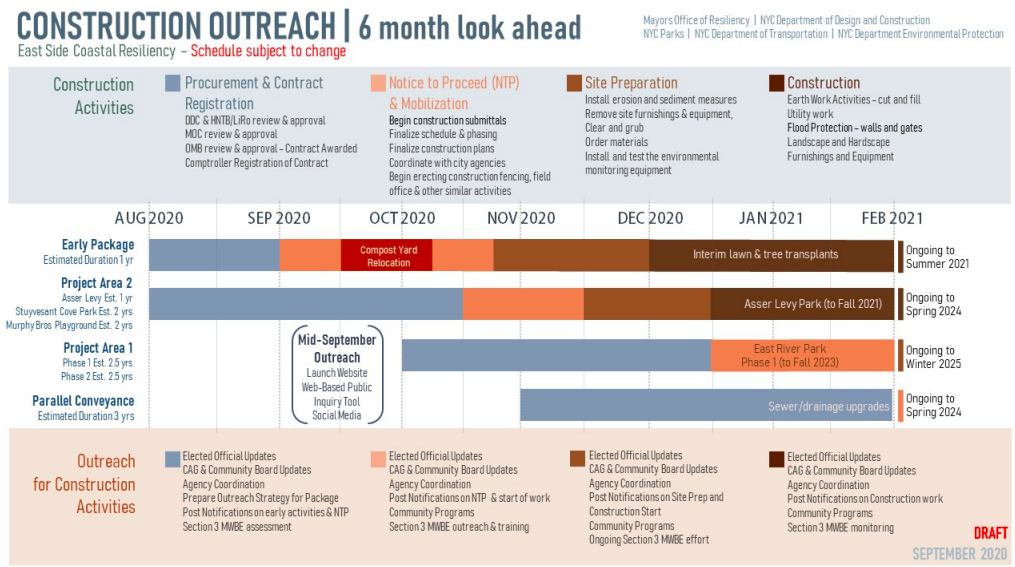MANHATTAN – THE BIG U has been divided into multiple sections for implementation, which have different implementing agencies and have different construction schedules. See below for information on each:
East Side Coastal Resilience (ESCR), East 25th St. to Montgomery St. – The City is finalizing the construction firm for the first phase of the BIG U, named the East Side Coastal Resilience Project and expects a “notice to proceed” this fall. The site will be prepped late fall for construction to begin before the end of this year. A Community Advisory Group has been selected for the duration of construction, and The Pratt Center has been chosen to be an outside facilitator to this group. You can read the summary of their first meeting here. The selected engineering firm will additionally hire community coordinators for each section of the project to be the point person for any questions or issues.
The City has committed to keeping at least 42% of East River Park open at all times during construction. There will be a series of improvements to nearby parks and open spaces to mitigate the closure of East River Park during construction. The Department of Design and Construction (DDC) has launched an updated website for the project here. Additionally, the schedule for the opening of the neighborhood interim recreation improvements can be found here. You can download the schedule of construction for ESCR and updated planning documents here.
Lower Manhattan Coastal Resiliency (LMCR) consists of four projects South of Montgomery Street:
Brooklyn Bridge Montgomery Coastal Resiliency (BMCR), Montgomery St. to Brooklyn Bridge – BMCR is one of several projects in the Lower Manhattan Coastal Resiliency (LMCR) portfolio. BMCR is nearing 75% design. The plans have been submitted to the NYC Public Design Commission for review and will be on the agenda for their October meeting. As a result of community feedback, designs for the location and size of the basketball court, seating area and equipment have been modified. The design also incorporates using a platform to reduce future inundation from SLR, and a combination of flip up gates, roller gates, and static structures to protect against surge. You can view updated renderings and the project schedule here.
FINANCIAL DISTRICT AND SEAPORT CLIMATE RESILIENCE MASTER PLAN, Brooklyn Bridge to the Battery – The City has selected an interdisciplinary team and a group of stakeholders (Climate Coalition of Lower Manhattan) to explore a range of options to protect the Financial District and Seaport, including extending the shoreline into the East River. The lack of above and below ground space within the FiDi-Seaport neighborhoods, makes it particularly challenging to site the critical flood protection and sewer infrastructure needed for this area.
Over three hundred attendees participated in an interactive Open House event this past February which included facts about the area, large carpet-like maps to enable participants to “stand” in locations that will be flooded by future dates, and tools to demonstrate how the sewer system works. You can see the outreach tools that were developed for this event here.
The NYC Economic Development Corporation (NYCEDC) is modifying their outreach plans to ensure robust engagement can continue virtually during this time. They are also conducting the largest ecological study of the East River, analyzing drainage infrastructure, and thinking about the future of our transportation and maritime infrastructure in the context of climate change.
The Battery Coastal Resilience, Battery Park – NYCEDC, in partnership with NYC Parks, BPCA and the Battery Conservancy, will invest $165 million to elevate the waterfront esplanade to protect against sea level rise. This design will preserve the look and feel of the existing park while protecting it and the neighborhood from a 100-year storm surge in the 2050s. Construction will begin in 2021.
Batter Park City Resilience Projects, Battery Park City – The Battery Park City Authority is at work on four interrelated resiliency projects which will create a continuous flood barrier from the Museum of Jewish Heritage, through Wagner Park, across Pier A Plaza, and along the northern border of Historic Battery Park. With construction scheduled to begin in 2020 and end in 2022, this structure will meander through this area at various heights in response to the area’s elevation. The Battery Park City Authority regularly presents to CB1’s Environmental Protection Committee. You can find all past presentations here and the upcoming schedule here.

